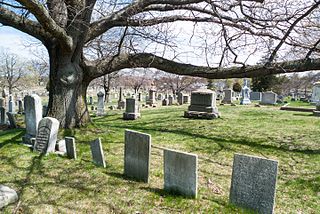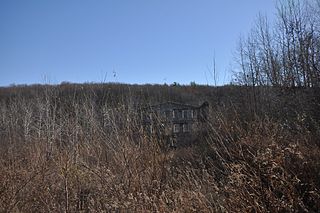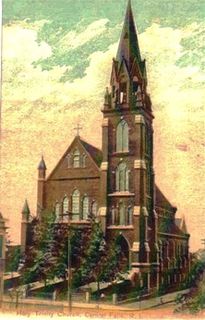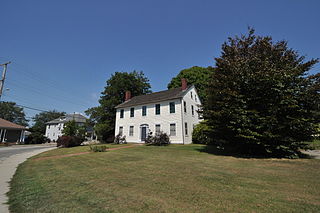
Zachariah Allen was an American textile manufacturer, scientist, lawyer, writer, inventor and civil leader from Providence, Rhode Island. He was educated at Phillips Exeter Academy and at Brown University where he graduated in 1813.

The North Burial Ground is a 110-acre (0.45 km2) cemetery in Providence, Rhode Island dating to 1700, the first public cemetery in Providence. It is located north of downtown Providence, bounded by North Main Street, Branch Avenue, the Moshassuck River, and Cemetery Street. Its main entrance is at the junction of Branch and North Main. The burial ground is one of the larger municipal cemeteries in Southern New England, and it accepts 220 to 225 burials per year.

Oakland is a village in Burrillville, Providence County, Rhode Island, United States. It was developed in the 19th century at the site of a stone mill near the confluence of the Chepachet and Clear Rivers. It is one of the few remaining stone mills in this state. Most of the village is included in the Oakland Historic District, a historic district listed on the National Register of Historic Places. Most of the housing in the village was originally built to house mill workers, although there are several more elaborate houses built for mill executives.

Allendale Mill is a historic mill at 494 Woonasquatucket Avenue in North Providence, Rhode Island, on the banks of the Woonasquatucket River.

Allenville Mill Storehouse is a historic mill storehouse at 5 Esmond Street in Esmond, Rhode Island within the town of Smithfield, Rhode Island. The exact date of construction is unknown, but it was built with rubble masonry construction which was typical of mill construction during and after the War of 1812. In 1813, Phillip Allen purchased 4.5 acres of land and constructed a mill on the site, but the first record to specifically refer to the storehouse was an insurance policy from 1836. Allen sold the property in 1857 and it changed ownership several times before it became Esmond Mills in 1906. In 1937, the building was used as a post office and described erroneously as the "Old Allenville Mill". The building has had some alterations to the front door and possibly the addition of a side door, but the interior of the structure was not detailed in the National Register of Historic Places nomination. The Allenville Mill Storehouse was added to the National Register of Historic Places in 1972.

The Central Street School is an historic school building located at 379 Central Street in Central Falls, Rhode Island. This 2 1⁄2-story wood-frame building was built by the city in 1881 to meet burgeoning demand for education brought about by the success of the local mills. The building is cruciform in shape, with Italianated hooded entrances at opposited ends of the east–west axis of the building. Each floor houses two classrooms.

The David G. Fales House is a historic house located at 476 High Street in Central Falls, Rhode Island.

The Benjamin F. Greene House is an historic house at 85 Cross Street in Central Falls, Rhode Island, USA. The Second Empire house was designed by Clifton A. Hall and built by Wheeler & Marchant in 1868. The house is one of a small number of high-style mid-19th century houses in the city. It was built for Benjamin Franklin Greene, a second-generation mill owner in the Central Falls/Pawtucket area.

The Holy Trinity Church Complex is an historic church complex on 134 Fuller Avenue in Central Falls, Rhode Island.

The Whitcomb Farm is an historic farmhouse in East Providence, Rhode Island. The 2 1⁄2-story structure was built c. 1780–1805, and is a well-preserved example of Federal architecture. Its construction is unusual, consisting of a brick structure finished with wood clapboards. The house has been owned by a number of prominent local citizens, including William Whitcomb, the proprietor the City Hotel in Providence.

The Candace Allen House is a historic house located at 12 Benevolent Street in the College Hill neighborhood of Providence, Rhode Island. Named after Candace Allen (1785-1872) an older sister of Zachariah Allen, a prominent Providence mill-owner.

The Allen–Madison House is a historic house on Marine Road in North Kingstown, Rhode Island. It is located on the grounds of the former Davisville Naval Construction Battalion Center, set on an isolated plot apart from the main portion of the base.

The Morris Brown House is a historic house located in Providence, Rhode Island. The house was listed on the National Register of Historic Places on August 22, 1991.

The Ernest Street Sewage Pumping Station is an historic wastewater pumping station at Ernest and Ellis Streets near the wastewater treatment facility at Field's Point in Providence, Rhode Island. The surviving elements of the station include a main pumphouse and a smaller screening house, both built in 1897-98 as part of a major effort to modernize Providence's sewage treatment facilities. A third structure, a boiler house, was demolished in 1987, and a tall smokestack was taken down in the 1930s. The main pumphouse is a tall single-story brick structure with a hip roof and Colonial Revival features, and is set near Ernest Street, a short way east of its junction with Allens Avenue. The screening house is a smaller square structure, also with a hip roof, set behind and to the right of the pumphouse. The facility is used to pump raw sewage through an 88-inch main to the treatment facility.

The Joseph Haile House is an historic house in the College Hill neighborhood of Providence, Rhode Island. It is a 3 1⁄2-story brick structure, appearing taller than that due to its hillside location and raised basement. It is a well-preserved example of Federal styling, which underwent a careful restoration in the 1930s by George Warren Gardner, who filled the house with early American furniture. The Gardners bequested the property to Brown University, which uses it to house visiting dignitaries.

The Thomas F. Hoppin House is a historic house at 383 Benefit Street in the College Hill neighborhood of Providence, Rhode Island. The house was built c. 1853 to a design by Alpheus C. Morse, and is an elaborate local example of an Italianate palazzo-style residence. The Hoppins were well known for the social gatherings, and their house became known as the "house of a thousand candles". The Library of Congress called the property "one of the largest and most elegant houses built in Providence in the mid-nineteenth century." At one time, the front lawn was home to "The Sentinel," a bronze statue of a dog, which was designed by Hoppin and cast by the Gorham Company; the statue was later moved to Roger Williams Park.

The Plain Farm House is an historic house in Providence, Rhode Island. It is a 2 1⁄2-story wood-frame structure, five bays wide, with a central entry flanked by sidelight windows and topped by a semi-elliptical fan. The house was probably built in the early 19th century, based on its Federal styling, and on the opening of the nearby Norwick Pike in 1803. At the time of its construction the area was part of Johnston, and was annexed to Providence in 1898. Once the main house of a large farm, it is now surrounded by residential development.

The Joseph and William Russell House is a historic house at 118 North Main Street in the College Hill area of Providence, Rhode Island. It is a brick Georgian house built in 1772. Its original interior woodwork has been removed and distributed among museums around the United States.

The Providence Gas Company Purifier House is a historic building at 200 Allens Avenue in Providence, Rhode Island. It is a large four-story steel-and-concrete structure, built in 1900 by the Berlin Iron Bridge Company, early in the era of steel frame construction. It was used for the gasification of coal until about 1940, when it was purchased by the City Tire Company, which occupied it until 2000. The building has been rehabilitated and converted for a variety of other uses.

The Moses Taft House is a historic house at 111 East Wallum Lake Road in Burrillville, Rhode Island. The 1 1⁄2-story side-gable Cape style house was built in 1786, and is a well-preserved example of early Federal architecture. It exhibits the typical five-bay facade, with the entry in the center bay, and a large central chimney. The house underwent a major restoration in the 2000s. Moses Taft, an early owner of the house, was a farmer and operated a nearby grist mill on the Clear River, with Seth Ross, who resided on Eagle Peak Road.






















